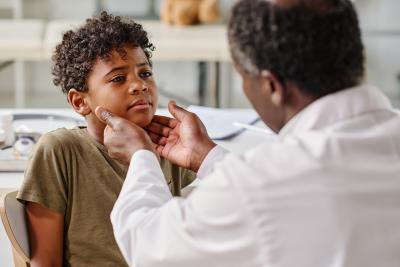Sore Throat

Sore throat is common in children. Let’s review four of the most common causes of sore throat and some tips for how to differentiate them. We’ll also discuss how you can keep your child comfortable and when antibiotics may be needed.
1 - Common cold: The majority of sore throats are caused by a viral illness. The common cold can be caused by a variety of different respiratory viruses including rhinovirus, respiratory syncytial virus (RSV), adenovirus, or parainfluenza virus. The common cold can cause fever, headache, sore throat, cough, sneezing, nasal congestion, and runny nose. Sore throat is more commonly present at the beginning of a cold. Symptoms may worsen over the first few days and then gradually improve over 10 - 14 days. The recommended treatment for a cold is supportive care. This can include fluids, rest, nasal saline, cool mist humidifier, and acetaminophen or ibuprofen as needed for fever or pain.
2 - Strep throat: Strep throat is a bacterial infection most commonly seen in children ages 5 - 15 years old. It is rare in infants and toddlers. In addition to sore throat, symptoms of strep throat may include fever, headache, abdominal pain, nausea or vomiting, tender swollen lymph nodes in the neck, and a sandpaper-like rash. Cough and runny nose are not typically seen with strep infection. Strep throat is diagnosed with a throat swab. Strep should be treated with antibiotics and symptoms typically resolve within 1 - 3 days of starting treatment.
3 - Hand foot and mouth: Hand foot and mouth is caused by a family of viruses called enteroviruses. Typical symptoms include fever, sore throat (with red spots, blisters, and ulcers in the mouth and throat), and rash. The rash is classically located on the hands, feet, buttocks, and around the mouth and is often seen on the legs and arms as well. Symptoms typically resolve within 7 days.
Herpangina is a similar illness in which symptoms include a higher fever and sore throat but no rash. These illnesses most commonly affect infants and young children but can be seen in all age groups. Treatment is supportive care with rest, fluids, and acetaminophen or ibuprofen for pain or fever.
4 - Infectious mononucleosis (commonly referred to as “mono”): Mono is another viral cause of sore throat, typically caused by Epstein-Barr virus (EBV). Mono is most commonly seen in adolescents and young adults. Classic symptoms include fever, sore throat (often with white patches in the back of the throat), swollen lymph nodes, and fatigue. Other symptoms may include headache, chills, puffy eyelids, and enlargement of the liver and spleen. Mono is diagnosed with a blood test. Most symptoms resolve within 1 month but the fatigue can last for several months. Individuals with mono should not participate in full contact sports if they have spleen enlargement with mono due to the risk of rupture; these children may need an additional evaluation in our office before return to play.
Treatment of mono includes rest, fluids, and acetaminophen or ibuprofen.
If sore throat symptoms continue for more than 7 days or present with a combined fever of over 100.4 for more than 3 days, call our office to speak with a triage nurse or make an appointment to be seen in one of our offices.
